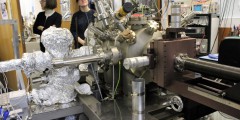Science communication: Mary Somerville
December 30, 2016
Every so often, and yet again just before Christmas this year, little skirmishes erupt on the history of science scene when somebody says that the word ‘scientist’ was first coined for Mary Somerville. The claim is then rebuffed by pointing out that the term was first used in print in 1834 in a review of …
Science communication in a hyper-real world
November 21, 2016
I recently asked myself the question: Is there still a point in doing or thinking about ‘science communication‘ in a world where facts have become indistinguishable from fiction and where experts and scientists are regarded with suspicion. This question struck me again quite forcefully when listening to the Now Show on Saturday 19 November, a …
Crowdfunding Science
October 14, 2016
This is guest post by Mike S. Schäfer, Professor of Science Communication at the Institute of Mass Communication and Media Research (IPMZ) and Director of the Center for Higher Education and Science Studies at the University of Zürich, Switzerland. Heather Richards was short of $3000, and she could still not realize her research project. The …
Radhika, Kim and the quantum cat: Graphic nanoscience
September 24, 2016
Some months ago I wrote a blog post about a physics project I am involved in here at the University of Nottingham, led by Professor Philip Moriarty which we call for short: 3D printing with atoms. I am engaged with the project as a social scientist interested in examining how such difficult research is being …
Camille Flammarion: Making science popular
July 22, 2016
Life on this planet is currently crazy, chaotic and confusing. In this context, I was thinking – wouldn’t it be nice to be able to poke one’s head out of the earthly firmament and look at the heavens beyond. This thought popped into my head because I had once seen an image depicting something like …
Science communication and the role of the Government
May 5, 2016
On 23 March 2016 the Science and Technology Committee launched an “inquiry on how the Government, scientists, the media and others encourage and facilitate public awareness of – and engagement in – science.” Science communication inquiry Two responses to this ‘Science communication inquiry’ have so far been submitted (as far as I am aware), one …
Synthetic Biology and Responsible Language Use: An anthology of blog posts
April 11, 2016
Over the last couple of years I have written quite a few blog posts on synthetic biology and responsible research and innovation, focusing in particular on the use of metaphors in both science and policy/politics. I have now assembled them, DIY fashion, into a little ‘booklet’. If anybody has the time and/or inclination to do …
3D printing with atoms: Beginning a story
March 8, 2016
A while ago Phil Moriarty published a post here on the ‘Making Science Public’ blog to announce a new project in which we are both involved. He talked about ‘impact’, or rather, the ‘non-impact’ type public engagement work we want to do. The project deals with Mechanochemistry at the single bond limit: Towards deterministic epitaxy. …
The crucial role of culture in climate change
September 5, 2015
On Wednesday, I attended the US Ambassador’s ‘digital dialogue’ event on climate change at Winfield House, where policy wonks, journalists, NGO representatives and academics discussed their current hopes and frustrations. Beyond the usual grumbles about ‘bogus arguments’ against climate action, it was pleasing that some attendees outside of the social sciences chose to highlight the key role of cultural …
What role for a scientist in political science communication?
April 10, 2015
This is a GUEST POST by ATHENE DONALD, Professor of Experimental Physics at the University of Cambridge and Master of Churchill College. A couple of months ago Brigitte Nerlich, who hosts this blog, asked me to contribute a post. As it happened, when she sent me the invitation I had just read, and possibly inwardly …









